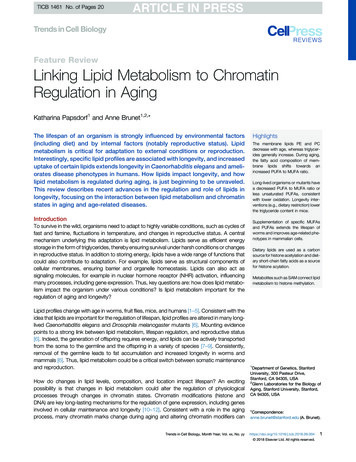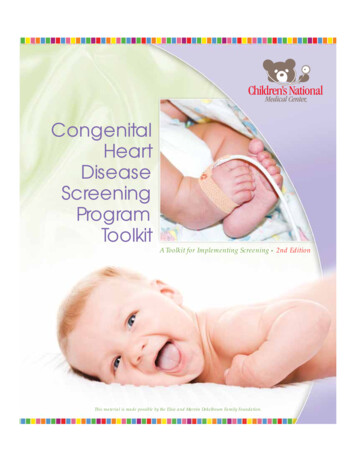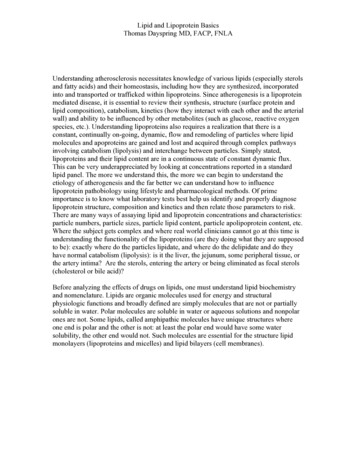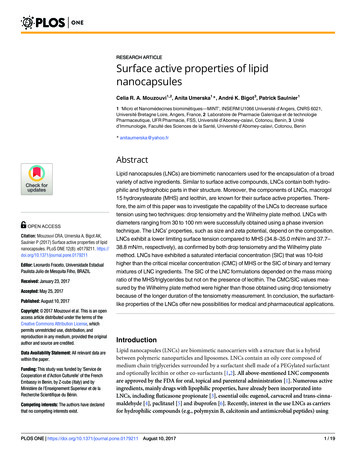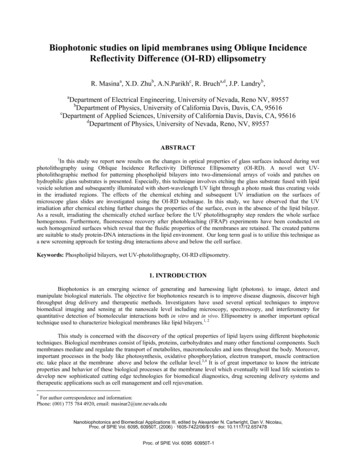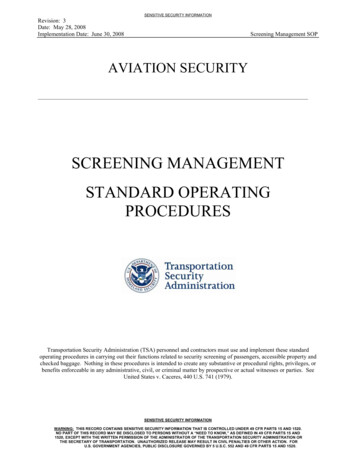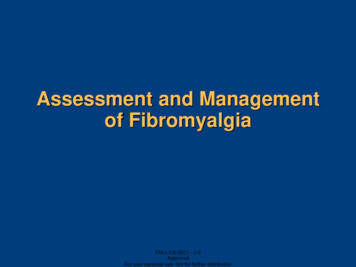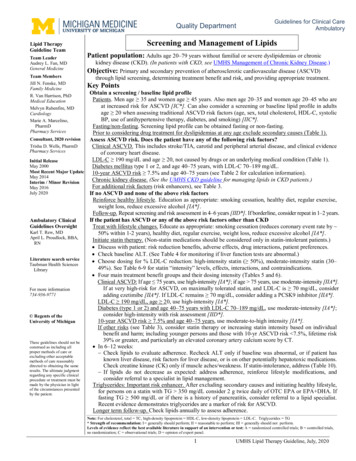
Transcription
Quality DepartmentLipid TherapyGuideline TeamTeam LeaderAudrey L. Fan, MDGeneral MedicineTeam MembersJill N. Fenske, MDFamily MedicineGuidelines for Clinical CareAmbulatoryScreening and Management of LipidsPatient population: Adults age 20–79 years without familial or severe dyslipidemias or chronickidney disease (CKD). (In patients with CKD, see UMHS Management of Chronic Kidney Disease.)Objective: Primary and secondary prevention of atherosclerotic cardiovascular disease (ASCVD)through lipid screening, determining treatment benefit and risk, and providing appropriate treatment.Key PointsObtain a screening / baseline lipid profilePatients. Men age 35 and women age 45 years. Also men age 20–35 and women age 20–45 who areat increased risk for ASCVD [IC*]. Can also consider a screening or baseline lipid profile in adultsMelvyn Rubenfire, MDage 20 when assessing traditional ASCVD risk factors (age, sex, total cholesterol, HDL-C, systolicCardiologyBP, use of antihypertensive therapy, diabetes, and smoking) [IIC*].Marie A. Marcelino,PharmDFasting/non-fasting. Screening lipid profile can be obtained fasting or non-fasting.Pharmacy ServicesPrior to considering drug treatment for dyslipidemias at any age exclude secondary causes (Table 1).Consultant, 2020 revisionAssess ASCVD risk. Does the patient have any of the following risk factors?Trisha D. Wells, PharmDClinical ASCVD. This includes stroke/TIA, carotid and peripheral arterial disease, and clinical evidencePharmacy Servicesof coronary heart disease.LDL-C 190 mg/dL and age 20, not caused by drugs or an underlying medical condition (Table 1).Initial ReleaseMay 2000Diabetes mellitus type 1 or 2, and age 40–75 years, with LDL-C 70–189 mg/dL.Most Recent Major Update10-year ASCVD risk 7.5% and age 40–75 years (see Table 2 for calculation information).May 2014Chronic kidney disease. (See the UMHS CKD guideline for managing lipids in CKD patients.)Interim / Minor RevisionFor additional risk factors (risk enhancers), see Table 3.May 2016July 2020If no ASCVD and none of the above risk factorsReinforce healthy lifestyle. Education as appropriate: smoking cessation, healthy diet, regular exercise,weight loss, reduce excessive alcohol [IA*].Follow-up. Repeat screening and risk assessment in 4–6 years [IID*]. If borderline, consider repeat in 1–2 years.If the patient has ASCVD or any of the above risk factors other than CKDAmbulatory ClinicalGuidelines OversightTreat with lifestyle changes. Educate as appropriate: smoking cessation (reduces coronary event rate by Karl T. Rew, MD50% within 1-2 years), healthy diet, regular exercise, weight loss, reduce excessive alcohol [IA*].April L. Proudlock, BBA,Initiate statin therapy. (Non-statin medications should be considered only in statin-intolerant patients.)RN Discuss with patient: risk reduction benefits, adverse effects, drug interactions, patient preferences. Check baseline ALT. (See Table 4 for monitoring if liver function tests are abnormal.)Literature search service Choose dosing for % LDL-C reduction: high-intensity statin ( 50%), moderate-intensity statin (30–Taubman Health Sciences49%). See Table 6-9 for statin “intensity” levels, effects, interactions, and contraindications.Library Four main treatment benefit groups and their dosing intensity (Tables 5 and 6).Clinical ASCVD: If age 75 years, use high-intensity [IA*]; if age 75 years, use moderate-intensity [IIA*].If at very high-risk for ASCVD, on maximally tolerated statin, and LDL-C is 70 mg/dL, considerFor more information734-936-9771adding ezetimibe [IIA*]. If LDL-C remains 70 mg/dL, consider adding a PCSK9 inhibitor [IIA*].LDL-C 190 mg/dL, age 20, use high-intensity [IA*].Diabetes (type 1 or 2) and age 40–75 years with LDL-C 70–189 mg/dL, use moderate-intensity [IA*];consider high-intensity with risk assessment [IID*]. Regents of the10-year ASCVD risk 7.5% and age 40–75 years, use moderate-to-high intensity [IA*].University of MichiganIf other risks (see Table 3), consider statin therapy or increasing statin intensity based on individualbenefit and harm; including younger persons and those with 10-yr ASCVD risk 7.5%, lifetime risk39% or greater, and particularly an elevated coronary artery calcium score by CT.These guidelines should not be In 6–12 weeks:construed as including allproper methods of care or Check lipids to evaluate adherence. Recheck ALT only if baseline was abnormal, or if patient hasexcluding other acceptableknown liver disease, risk factors for liver disease, or is on other potentially hepatotoxic medications.methods of care reasonablydirected to obtaining the sameCheck creatine kinase (CK) only if muscle aches/weakness. If statin-intolerance, address (Table 10).results. The ultimate judgment Iflipids do not decrease as expected: address adherence, reinforce lifestyle modifications, andregarding any specific clinicalconsider referral to a specialist in lipid management.procedure or treatment must bemade by the physician in lightTriglycerides: Important risk enhancer. After excluding secondary causes and initiating healthy lifestyle,of the circumstances presentedfor persons on a statin with TG 350 mg/dL consider 2 g twice daily of OTC EPA or EPA DHA. Ifby the patient.fasting TG 500 mg/dL or if there is a history of pancreatitis, consider referral to a lipid specialist.Recent evidence demonstrates triglycerides are a marker of risk for ASCVD.Longer term follow-up. Check lipids annually to assess adherence.R. Van Harrison, PhDMedical EducationNote: For cholesterol, total TC, high-density lipoprotein HDL-C, low-density lipoprotein LDL-C. Triglycerides TG* Strength of recommendation: I generally should perform; II reasonable to perform; III generally should not perform.Levels of evidence reflect the best available literature in support of an intervention or test: A randomized controlled trials; B controlled trials,no randomization; C observational trials; D opinion of expert panel.1UMHS Lipid Therapy Guideline, July, 2020
Table 1. Secondary Causes of HyperlipidemiaSecondary CauseElevated LDL-CElevated TriglyceridesDietSaturated or trans fats, weightgain, anorexia nervosaWeight gain, very low-fat diets, high intake of refinedcarbohydrates, excessive alcohol intakeDrugsDiuretics, cyclosporine,glucocorticoids, amiodaroneOral contraceptives, estrogens, glucocorticoids, bile acidsequestrants, protease inhibitors, retinoic acid, anabolicsteroids, sirolimus, raloxifene, tamoxifen, beta blockers (notcarvedilol), thiazidesDiseasesBiliary obstruction, nephroticsyndrome, chronic kidneydiseaseNephrotic syndrome, chronic kidney disease, lipodystrophies,Cushing syndromeDisorders and alteredstates of metabolismHypothyroidism, obesity,pregnancy*Diabetes (poorly controlled), hypothyroidism, obesity, inactivity;pregnancy** Cholesterol and triglycerides rise progressively throughout pregnancy. Note that statins, niacin, and ezetimibe arecontraindicated during pregnancy and lactation.Adapted from 2013 ACC/AHA Guideline on the Treatment of Blood CholesterolTable 2. 10-Year Risk Assessment for ASCVDTen-year risk is defined as the risk of developing a first ASCVD event (nonfatal MI, CHD death, fatal or nonfatal stroke) over a10-year period among people free from ASCVD at the beginning of the period.Pooled Cohort Equations estimate 10-year ASCVD risk in individuals age 40–79 years with and without diabetes. Adownloadable spreadsheet enabling estimation of 10-year and lifetime risk for ASCVD and a web-based calculator areavailable at http://my.americanheart.org/cvriskcalculatorRisk is calculated based on: gender, age (40–79 years), race (African American or whites/others), total cholesterol, HDLcholesterol, systolic blood pressure, treatment for high blood pressure (Y/N), diabetes (Y/N), and smoker (Y/N).The Pooled Cohort Equation may be revised in the near future due to concerns of over-estimating risk particularly in those witha healthy lifestyle, well educated, and higher socioeconomic status. However, a 10-yr risk score cutoff of 7.5% may bereasonable to initiate a conversation between clinician and patient regarding ASCVD risk reduction (see text on AssessingASCVD Risk Factors).When compared with non-Hispanic Whites, the estimated 10-year risk for ASCVD is generally lower in Hispanic-American andAsian-American populations and higher in American-Indian populations. If using equations for non-Hispanic Whites for otherrace/ethnic groups, the estimated risks may be over-estimates, especially for Hispanic- and Asian-Americans.2UMHS Lipid Therapy Guideline, July, 2020
Table 3. Patient Factors that May Enhance Risk for ASCVD or Increase Benefit from Statin TherapyIn selected individuals who are not in the four main statin benefit groups (see Table 5), and for whom a decision to initiate statintherapy is otherwise unclear, additional factors may be considered to inform treatment decision making:Risk enhancers include:Family history of premature ASCVD, with onset 55 years of age in a first degree male relative, or 65 years of age in a firstdegree female relativePrimary hypercholesterolemia, including LDL-C 160–189 mg/dL, or non-HDL-C 190–219 mg/dLMetabolic syndrome. The NCEP ATP III defines metabolic syndrome as a diagnosis of 3 or more of the following risks:– Waist circumference 40 inches (102 cm) for men or 35 inches (88 cm) for women– HDL-C 40 mg/dL for men or 50 mg/dL for women– Impaired fasting glucose 100 mg/dL*– Triglycerides 150 mg/dL– Blood pressure 130/85 mm HgChronic kidney disease (eGFR 60 mL/min/1.73m2)Chronic inflammatory conditions, such as psoriasis, SLE, rheumatoid arthritis, human immunodeficiency virus (HIV)History of preeclampsiaHistory of premature menopause (age 40 years)High-risk ethnic groups (eg, South Asian)Current tobacco userFactors associated with increased ASCVD risk:– Persistent elevations of triglycerides 175 mg/dL– High-sensitivity C-reactive protein 2 mg/L– Apolipoprotein B 130 mg/dL– Lipoprotein (a) 50 mg/dL or 125 nmol/L, especially at higher values of lipoprotein (a)– Ankle-brachial index 0.9– Coronary artery calcium (CAC) score 100, or 75th percentile for age, sex and ethnicity*The American Diabetes Association defines impaired fasting glucose as 100 mg/dL. SLE Systemic lupus erythematosus.Adapted from: 2018 Guideline on the Management of Blood Cholesterol: Guidelines Made Simple (updated June 2019).Washington, DC: American College of Cardiology, 2019.Table 4. Monitoring Abnormal Baseline ALTCareful follow-up of liver tests is indicated for those with known liver disease, risk factors for liver disease, or who are on otherpotentially hepatotoxic medications. When ALT is elevated and TG 200 mg/dL in patients with diabetes, pre-diabetes, or themetabolic syndrome, consider hepatic ultrasound for NAFLD/NASH/cirrhosis. For other patients: If baseline liver function tests (LFTs) are normal, no further monitoring is required.If baseline LFTs are mildly abnormal (over upper limit of normal [ULN] but 2 times the ULN): reassess LFTs after 6–12weeks of statin treatment for stability. If ALT 2 ULN, consider screening for liver disease to clarify the cause of theelevated ALT, so as not to have to stop statins. Consider monitoring annually for stability if baseline LFTs are abnormal.Abnormal baseline liver biochemistries can frequently improve with statin therapy.3UMHS Lipid Therapy Guideline, July, 2020
Table 5. Main Groups Likely to Benefit from Lipid TreatmentRisk GroupTreatmentSecondary PreventionPatients with clinical ASCVD (angina, ACS, PCI, CABG, PVD,stroke/TIA, evidence of ischemia on stress testing, carotid plaque,aortic aneurysm)If very high-risk ASCVD aIf on maximal statin and LDL-C 70 mg/dLIf LDL-C still 70 mg/dL or non-HDL-C 100 mg/dLHigh-intensity or maximal statinConsider adding ezetimibeConsider adding a PCSK9 inhibitorIf not very high-risk ASCVDIf age 75If age 75If high-intensity statin not toleratedIf on maximal statin and LDL-C 70 mg/dLConsider initiating/continuing high-intensity statinHigh-intensity statin to reduce LDL-C 50%Moderate-intensity statinMay consider adding ezetimibePrimary Prevention (assess ASCVD risk)LDL-C 190 mg/dLHigh-intensity statinDiabetes mellitus and age 40–75 and LDL-C 70 mg/dLModerate-intensity statinIf multiple risk factorsIf 10-year ASCVD risk of 20%Consider high-intensity statin to reduce LDL-C 50%Consider adding ezetimibe to max tolerated statin toreduce LDL-C 50%Other patientsIf Age 40–75 and LDL-C is 70–189 and ASCVD risk is: 20% (high risk)7.5–19.9% (intermediate risk)If risk enhancers (see Table 3)If risk decision is uncertainStatin to reduce LDL-C 50%Moderate-intensity statin to reduce LDL-C 30–49%Consider measuring coronary artery calcium (CAC)score bEmphasize heart-healthy lifestyleIf no risk enhancers5–7.4% (borderline risk)If risk enhancers (see Table 3)If no risk enhancers 5% (low risk)Discuss moderate-intensity statin therapyEmphasize heart-healthy lifestyleEmphasize heart-healthy lifestyleIf age 20–39If family history of premature ASCVD and LDL-C 160 mg/dLOthersConsider statinEmphasize heart-healthy lifestyleAdapted from: 2018 Guideline on the Management of Blood Cholesterol: Guidelines Made Simple (updated June 2019).Washington, DC: American College of Cardiology, 2019.aVery high-risk for future ASCVD events: Either multiple ASCVD events or 1 major and multiple high-risk conditions. Major ASCVD events: acute coronary syndrome within past 12 months, history of myocardial infarction (other than recentsyndrome), history of ischemic stroke, symptomatic peripheral arterial disease. High-risk conditions: age 65, heterozygous familial hypercholesterolemia, history of prior coronary artery bypass surgery orPCI outside of the major ASCVD events, diabetes mellitus, hypertension, chronic kidney disease (eGFR 60mL/min/1.73m2), current smoking, persistently elevated LDL-C (LDL-C 100 mg/dL) despite maximally tolerated statintherapy and ezetimibe, history of congestive heart failure.bCoronary artery calcium (CAC) score: if CAC 0, lower risk, no statin (unless diabetes, family history of premature ASCVD, orcigarette smoker); if CAC is 1–99, statin is favored (especially age 55); if CAC 100 or 75th percentile for age, sex, andethnicity, initiate a statin.4UMHS Lipid Therapy Guideline, July, 2020
Table 6. Statin Dose Intensity and Equivalency Chart*Statin%LDL-CIntensity ReductionHighIntensity(lowersLDL-C statin20 mg( 8 gen, 242 br)10 mg( 7 gen, 242 br)40mg( 7 gen, 508 br)40 mg( 4 gen, 261 br)4 mg(N/A gen, 293 br)3428262422Lovastatin Pravastatin Fluvastatin80mg( 8 gen, 508 br)20mg( 7 gen, 508 br)383630Simvastatin40 mg( 11 gen, 242 br)4032LowIntensity(lowersLDL-C 30%)Statin (HMG-CoA Reductase Inhibitor) Options5 mg( 10 gen, 242 br)10mg( 6 gen, 356 br)20 mg( 4 gen, 261 br)2 mg(N/A gen, 293 br)10 mg( 4 gen, 150 br)1 mg(N/A gen, 293 br)5 mg( 5 gen, 75 br)201880mg( 8 gen, 263 br)40mg( 6 gen, 132 br)20 mg(54 gen, 79 br)10 mg( 5 gen, 44 br)80 mg( 13 gen, 367 br)40 mg( 8 gen, 183 br)20mg( 9 gen, 125 br)10mg( 7 gen, 63 br )80mg( 137 gen, 350 br)40mg( 122 gen, 175 br)20mg( 122 gen, 88 br)Note: Consider the similar cost for generics after considering the potential for drug interactions (Tables 8 and 9). The high potencystatins are preferred with dose adjustment, as needed. Avoid simvastatin and lovastatin because of increased druginteractions and myopathy. The shading reflects doses listed in the ACC/AHA Guideline on Treatment of Blood Cholesterol(2013) as reflecting high-intensity therapy ( 50% reduction in LDL-C, darker shading) and moderate-intensity therapy(30-49% reduction in LDL-C, lighter shading).5UMHS Lipid Therapy Guideline, July, 2020
Table 7. Drug Therapy SummaryDrug & StrengthDose Range /Mo brandaLDL-CHDL-CTG 6-8 202-29039 60% 5 9% 19 37% 5 40 mg/d 10-11 92 all45 63 % 8 14 % 10 35% 1 4 mg/dN/A 33532 43% 5 8 15 18% 5 40 mg/d 5 76-13326 47% 8 16% 12 33% 20 80 mg/d b 70-135N/A80mg XL: 34880mg ER: 25019 32% 3 8% 0 11% 10 80 mg/d b 5-8 106424 40% 5 19% 3 22% 10 40 mg/d 7-8 125-12918 35% 4 16% 1 25% HMG-CoA Reductase Inhibitors (Statins)High PotencyAtorvastatin (Lipitor)10 80 mg/d10, 20, 40, 80 mgRosuvastatin (Crestor)*5, 10, 20, 40 mgModerate PotencyPitavastatin (Livalo)1, 2, 4 mgSimvastatin (Zocor)**5, 10, 20, 40 mgLow PotencyFluvastatin (Lescol XL)20, 40 mg capsule80 mg ER tabletLovastatin (Altoprev 24hour)***10, 20, 40 mgPravastatin (Pravachol)0, 20, 40, 80 mg /Mogeneric aGeneral Cautions about Drug ClassStatins are contraindicated in pregnancy/lactation. Premenopausal women should be advised regarding therisks of statins on the fetus, the need for birth controlmethods, and stopping statins upon missing a menstrualcycle.Liver function tests (LFTs) in 0.1–1.9%. Careful follow-upis indicated for those with known liver disease, riskfactors for liver disease, or who are on other potentiallyhepatotoxic meds. For other patients, if baseline LFTsare normal, no further monitoring is required. If baselineLFTs are mildly abnormal (over the upper limit of normal,but 3 times the upper limit of normal): monitor LFTsduring first 6 months of statin treatment for stability.Myopathy risk very low as monotherapy, but is increasedwith drugs that inhibit CYP3A4 (see Table 9). Routinecreatine kinase (CK) screening not proven beneficial.Avoid in combination with gemfibrozil.Dose adjustments are recommended for patients witheGFR 60 mL/min/1.73m2. No dose adjustmentnecessary for atorvastatin. See UMHS Management ofChronic Kidney Disease for dose recommendations inCKD.Doubling a statin dose reduces LDL-C by about 6-7%.Specific statin cautions:* Rosuvastatin drug levels are two fold higher in patientsof Asian descent; use with caution.**Simvastatin 80 mg dose is available but should beavoided considering other options.***Strong CYP3A4 inhibitors can increase atorvastatin,lovastatin, and simvastatin exposure increasing risk formuscle injury. See Table 10 for dose limitations withinteraction drugs.There is no established safety data for statins with ALT 3x the upper limit of normal (ULN); generally, avoid statins when ALT 3x ULN, unless found to be related to known liverdisease and risk/benefit is appropriate; severe liver disease is rare with statins. If ALT is 2x ULN at baseline, evaluate for liver disease; if present, monitor; a further moderateincrease in ALT is expected.Kim H, Kim TM, Yang SJ, Baik SY, Lee SH, Cho JH, Lee H, Yim HW, Choi IY, Yoon KH, Kim HS. Change in ALT levels after administration of HMG-CoA reductase inhibitors tosubjects with pretreatment levels three times the upper normal limit in clinical practice. Cardiovasc Ther. 2018 Jun;36(3):e12324. doi: 10.1111/1755-5922.12324. Epub 2018 Mar 6.6UMHS Lipid Therapy Guideline, July, 2020
Table 7. Drug Therapy Summary, continuedDrug & StrengthAbsorption InhibitorsBile Acid Resins:Cholestyramine (Questran,Questran Light)4 g resin/variable g powderColesevelam (Welchol)3.75 g/packet625 mg tabletColestipol (Colestid)5 g powder/1g tabEzetimibe (Zetia)Fibric Acid DerivativesFibratesGemfibrozil (Lopid)600 mg tabletFenofibratesAntara (micronized)43, 130 mg capsulesFenoglide40, 120 mg tabletsLipofen50, 150 mg capsulesTricor48, 145 mg tabletsTriglide50, 160 mg tabletsFenofibric AcidFibricor35, 105 mg tabletTriLipix45, 135 mg delayed releasecapsule /Mo gen a /Mo br aLDL-CHDL-CTG4 12 g BID 18–48 48-14415 30% 3 5% 0–20% 3.75 g/d or1.875 g BID 163 70015 18% 3% 9 10% 5–15 g BID 26-72 137-40915 30% 3 5% 0–20% 10 mg/d 9 37315 20% 1 4% 5 8% 600 mg BID 11 435 10%10% 43% 43 130 mg/dN/A 186-54917 35% 2 34% 32 53% 40 120 mg/dN/A 400-120050 150 mg/dN/A 117-25848 145 mg/d 11-12 18-3450 160 mg/dN/A 36935–105 mg/d 69 533-106445–135 mg/d 18-33 98-292Dose RangeGeneral Cautions about Drug ClassEffective and safe with statins.Take other meds 1 hour prior or 4 hours after, or take withdinner.May cause constipation, bloating, altered fat absorption.May decrease absorption of vitamins.Can increase triglyceride levels, avoid if TG level 300mg/dL.Ezetimibe is effective and safe with statins.Obtain baseline ALT, monitor at physician discretion, unlessat increased risk (see text).Contraindicated in hepatic disease or severe renal diseasewith GFR 10 mL/min.Risk of myopathy with statins.Dosage should be reduced in chronic kidney disease.Do not use gemfibrozil in conjunction with statins.Use lowest initial starting dose of fenofibrate dosage form inelderly.Increases effect of warfarin.Dosage should be reduced in chronic kidney disease. Renalfunction should be checked periodically, particularly whenit may impact renal function in the cardiorenal syndromeThe FDA has concluded that the totality of the scientificevidence no longer supports the conclusion that a druginduced reduction in triglyceride levels and/or increase inHDL-C levels in statin-treated patients results in areduction in the risk of cardiovascular events. Fibratesshould not be used in conjunction with statins forreduction in cardiovascular risk.7UMHS Lipid Therapy Guideline, July, 2020
Table 7. Drug Therapy Summary, continuedDrug & StrengthDose Range /Mo gen a /Mo br aLDL-CHDL-CTG500 1500 mgTID 116-230 349-6985 25% 15 35% 20 50% 24-44 296-5927 16% 14 22% 16 38% N/A 500-120043–64% 4.6–8.9% 6.5–17.35% General Cautions about Drug ClassNiacin c, dNiacin Immediate Release(IR) (Niacor)50, 100, 250, 500 mgNiacin Extended Release (ER) 1000 2000(Niaspan)mg/d500, 750, 1000 mgPCSK9 Inhibitors (continued on next page)Alirocumab (Praluent)75–150 mg75 mg/mL, 150 mg/mLsubcutaneouslyevery 2 weeks;300 mgsubcutaneouslyevery 4 weeksTake with meals to avoid flushing or gastrointestinal upset.Can pre-medicate with aspirin 325 mg, 30 minutes priorto dose to reduce flushing.Take Niaspan ER at bedtime with a low-fat snack.With Niaspan ER follow titration schedule: weeks 1–4: 500mg at bedtime; weeks 5–8: 1000 mg at bedtime; mayincrease dose by 500 mg/d every 4 weeks to a maxdose of 2 g/d. Do not crush tablets. Check LFTs atbaseline and 6 weeks after start or dosage change;monitor every 6–12 months thereafter.Causes glucose intolerance; caution in established orborderline diabetes.May cause gastrointestinal intolerance; caution withhistory of complicated active peptic ulcer disease.Urinary secretion of uric acid, caution with gout.Contraindicated in hepatic disease.Caution in renal impairment.The FDA has concluded that the totality of the scientificevidence no longer supports the conclusion that a druginduced reduction in triglyceride levels and/or increase inHDL-C levels in statin-treated patients results in areduction in the risk of cardiovascular events. Niacinshould not be used in conjunction with statins forreduction in cardiovascular risk.For LDL-C 190 mg/dL with family history of prematureASCVD or very high LDL-C, consider referring to a lipidspecialist for management.Used as add on therapy to statins in very high-riskpatients.Available in solution prefilled syringe or solutionautoinjector for subcutaneous injection.Maximum dose of 150 mg every 2 weeks.No dosing adjustment required for renal or hepaticimpairment.Can cause diarrhea, hypersensitivity reaction, myalgia,flu-like symptoms, and cough.No known significant drug interactions.8UMHS Lipid Therapy Guideline, July, 2020
Table 7. Drug Therapy Summary, continuedDrug & StrengthDose RangePCSK9 Inhibitors, continuedEvolocumab (Repatha)140 mg140 mg/mL, 420 mg/3.5 mL subcutaneouslyevery 2 weeks;420 mgsubcutaneouslyevery monthCombination ProductsEzetimibe and simvastatin(Vytorin)10/10, 10/20,10/40, 10/80 mg10/10–10/80(ezetimibe/simvastatin)mg/d /Mo gen aN/A 56-74 /Mo br aLDL-CHDL-CTGGeneral Cautions about Drug Class 150-490 302 allFor LDL-C 190 mg/dL with family history of prematureASCVD or very high LDL-C, consider referring to alipid specialist for management.Used for add on therapy to statins in very high-riskpatients.Available in solution for subcutaneous injection.420 mg/3.5 mL dose should be given over 9 minutes orin 3 separate 140 mg/mL injections consecutivelywithin 30 minutes.No dosing adjustment required for renal or hepaticimpairment.Can cause hypertension, dizziness, gastroenteritis, flulike symptoms, injection site reaction, URI, cough, andmyalgia.No known significant drug interactions.45–60% 6–10 % 23–31% Combination therapy (statin other lipid agent) improveslipids, but may increase myopathy risk, and has notbeen shown to result in a reduction in the risk ofcardiovascular events compared to statin monotherapy.a Cost Average Wholesale Price minus 10%. AWP from Lexicomp Online 02/2020. For generic drugs, Maximum Allowable Cost plus 3 from BCBS of Michigan MAC List, 02/2020.Dose given as 40 mg BID when total is 80 mg/d.c Generic niacin immediate release (IR) is inexpensive but not federally regulated and not well tolerated. Some OTC niacin SR formulations have been associated with hepatitis,fulminant hepatitis and death.d Start IR 50–100 mg BID–TID and dose by 300 mg/day per week; use titration pack. Usual maximum daily dose IR 3 g/dayb.9UMHS Lipid Therapy Guideline, July, 2020
Table 8. Common Drug InteractionsInteractive Agent(s)Statins a,bClinical ManifestationsFluconazole, itraconazole, ketoconazole,posaconazoleCyclosporine, tacrolimusClarithromycin, erythromycinVerapamil, diltiazem, amlodipineHIV protease inhibitors (eg, ritonavir)NefazodoneNiacin, fibratesDanazolRanolazineIncreased risk of myopathyNiacinStatinsIncreased risk of myopathy ( 1%) cResinsFat soluble vitaminsImpaired absorption (though vitamin supplement notroutinely necessary)Impaired absorption. Take all other meds 1 hourbefore or 4 hours after resinsIncreased risk of myopathy cIncreased risk of myopathy cIncreased risk of myopathy cIncreased risk of myopathy cIncreased risk of myopathy cIncreased risk of myopathy cIncreased risk of myopathy cIncreased risk of myopathy cAll other sed risk of myopathyIncreased INRMay increase risk of hypoglycemiaPravastatin, fluvastatin, rosuvastatin, and pitavastatin have a lower risk of drug interactions with other medicationsmetabolized through the CYP3A4 system than other statins. Simvastatin has a higher risk of myopathy compared to otherstatins.Grapefruit juice increases the risk of myopathy for statins that are metabolized by the cytochrome P450 3A4 system(atorvastatin, lovastatin, simvastatin). Avoid large quantities of grapefruit juice ( 1 quart daily).Consider statins not metabolized by the CYP3A4 enzymes, such as pravastatin, fluvastatin, rosuvastatin, and pitavastatin.Table 9. Simvastatin and Lovastatin Contraindications and Dose LimitationsSimvastatinLovastatinContraindicated with simvastatin:Calcineurin inhibitors anazolErythromycinGemfibrozilHIV protease zodoneContraindicated with lovastatin:ClarithromycinErythromycinHIV protease nazoleTelaprevirAvoid with lovastatin:Cyclosporine/tacrolimusGemfibrozilDo not exceed 10 mg simvastatin daily with:Diltiazem*Verapamil*Do not exceed 20 mg lovastatin daily with:DanazolDiltiazemRanolazineVerapamilDo not exceed 20 mg simvastatin daily with:AmiodaroneAmlodipineRanolazineDo not exceed 40 mg lovastatin daily with:Amiodarone*Contraindicated with Simcor (simvastatin/niacin ER) as Simcor is only available with 20 mg or 40 mg of simvastatin.10UMHS Lipid Therapy Guideline update, July 2020
Table 10. Management of Statin-Intolerant Patients1.Discontinue statin. For patients with mild to moderate muscle symptoms that develop during statin therapy, stop the statinuntil the symptoms can be evaluated. If more than moderate pains or sudden onset of pain or weakness occurs, considerexcluding rhabdomyolysis by evaluating with CK, creatinine, and checking a urinalysis for myoglobinuria.2.Secondary causes/conditions. Consider other conditions that may increase the risk for muscle aches or myopathy (eg,hypothyroidism, influenza, exercise, reduced renal or hepatic function, rheumatologic disorders, steroid myopathy, vitamin Ddeficiency, or primary muscle diseases). Consider drug interactions, such as concomitant use of certain statins (atorvastatin,lovastatin, simvastatin) and other agents that are metabolized by the cytochrome P450 3A4 system.3.Trial without statin. If muscle symptoms or elevated CK do not resolve completely after 2 months without statin treatment,consider other causes of muscle symptoms listed above. If persistent muscle symptoms are determined to arise from acondition unrelated to statin therapy, resume statin therapy at the original dose.4.Consider lower dose statin retrial. If muscle symptoms resolve after 2 months without statin treatment, and nocontraindication exists, consider retrial of the original or a lower dose of the same statin to establish a causal relationship.5.Alternative statin. If a causal relationship exists, stop the original statin. After muscle symptoms resolve, start an alternativelow dose statin (preferably rosuvastatin or pravastatin, and avoid trials of lovastatin or simvastatin), and titrate up slowly tomaximum tolerable dose.6.Intermittent statin dosing. If the patient has failed a trial of a second statin, consider a trial of low dose twice weekly oralternate day dosing of a long-acting statin, such as atorvastatin or rosuvastatin.7.Consider referral to lipid specialist. If the patient has failed both a second statin and alternate day statin dosing, considerreferring patient to a lipid specialist for further evaluation and treatment.Polypharmacy is an issue in secondary prevention. Patientsmay be hesitant to take another pill, especially one that maycause muscle ac
50% within 1-2 years), healthy diet, regular exercise, weight loss, reduce excessive alcohol [IA*]. Initiate statin therapy. (Non-statin medications should be considered only in statin-intolerant patients.) . Weight gain, very low-fat diets, high intake of refined carbohydrates, excessive alcohol intake : Drugs . Diuretics, cyclosporine,
